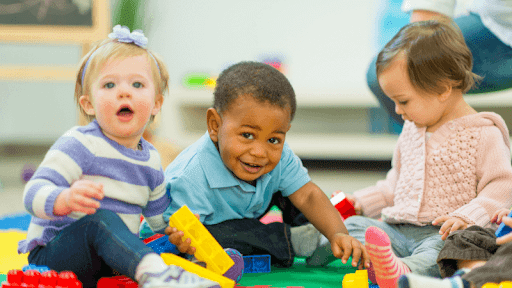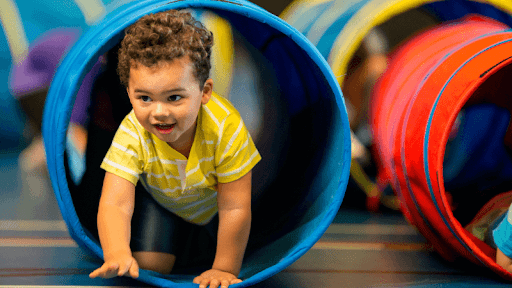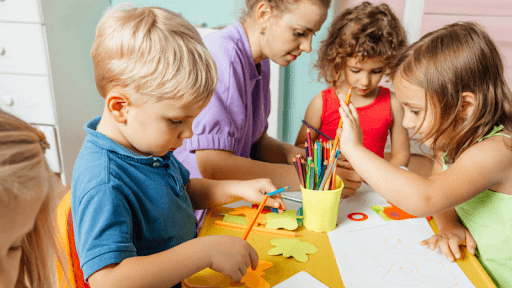What is Heuristic Play?
Complete Early Years Guide

The term “heuristic” comes from the Greek word “eurisko,” which means “I discover.” Therefore, heuristic play involves providing children with various natural materials they can use to explore and discover on their own terms. These materials are often open-ended and include shells, stones, pinecones, fabrics, and other objects with varying textures, shapes, and sizes.
Heuristic play is a child-led approach to play that prioritises the process of playing and discovery through sensory experiences, it is the play that allows children to experience and put together objects in a way that engenders the excited feeling – ‘I have found out about this object’. It is commonly used in early years settings and nurseries to encourage children’s development in various areas. This article will delve into heuristic play, its benefits, and the principles of incorporating it into early years settings.
Benefits of Heuristic Play

1. Promotes Curiosity and Creativity:
Heuristic play encourages children to use their imaginations and develop ideas, promoting curiosity and creativity.
Children are naturally curious and eager to learn about the world around them. Heuristic play stimulates their curiosity by providing them with a range of natural materials to explore and play with. It encourages them to investigate and discover the properties of the objects. This type of play allows children to engage in free-form experimentation without predefined objectives or outcomes, promoting their creativity and imagination.
Children can experiment with different materials and explore their properties in a safe and stimulating environment. They are encouraged to use their senses to investigate objects, to touch, smell, taste, see, and hear the results of their actions. It creates a rich sensory learning environment that stimulates their cognitive growth and development.
By promoting curiosity and creativity, heuristic play can significantly impact children’s development. It encourages them to take risks and try new things, fostering a sense of independence and self-confidence. This play type also helps children develop problem-solving and critical thinking skills as they learn to experiment and explore different approaches to achieve their goals.
2. Develops Fine Motor Skills and Hand-Eye Coordination:
Children can develop fine motor skills and hand-eye coordination by manipulating objects and exploring their properties.
Fine motor skills are essential for completing self-care tasks, activities of daily living (ADLs), and school and work-related duties. Examples of fine motor skills include:
- Brushing teeth.
- Writing with a pencil.
- Using a fork or spoon.
- Cutting with a knife or scissors.
- Buttoning a shirt.
Developing these skills is crucial for children’s physical, cognitive, and emotional development.
In heuristic play, children can explore and manipulate various natural materials, including shells, stones, pinecones, fabrics, and other objects with different textures, shapes, and sizes. This type of play allows children to practice their fine motor skills and hand-eye coordination as they use their fingers and hands to pick up, manipulate, and explore objects.
Children can improve their agility and coordination, which can help them with various activities in their daily lives. These skills are essential for school-related activities, such as writing and drawing. By developing their fine motor skills and hand-eye coordination through heuristic play, children can improve their academic performance and succeed tremendously in their future endeavors.
3. Supports Language Development:
Through exploring different materials, children are encouraged to use language to describe what they are doing and the properties of the objects they are manipulating. It can improve their communication skills and help them develop a more extensive vocabulary. Early years educators can create a rich language learning environment that fosters communication and social interaction by encouraging children to engage in heuristic play.
Furthermore, this type of play can help children develop their cognitive abilities as they learn to think and communicate about the world around them. Language development is crucial for children’s success in school and later in life, and heuristic play is a valuable tool for promoting it. By supporting children’s language development through heuristic play, educators can help them build strong communication skills and thrive in all aspects of their lives.
4. Helps Regulate Emotions:
The sensory exploration of different materials, shapes, textures, and colors can help children relax and engage in calming, repetitive movements that can soothe and calm their nervous systems. This type of play can be especially beneficial for children who struggle with emotional regulation or need a calming activity.
By allowing children to explore the materials freely and without adult guidance, heuristic play can also provide a safe space to express themselves and process their emotions. The open-ended nature of heuristic play encourages children to use their imaginations and develop their ideas, which can help them build self-confidence and resilience.
Heuristic play can be a valuable tool for supporting children’s emotional well-being and helping them learn to regulate their emotions healthily and constructively.

Principles of Heuristic Play

There are three key principles of heuristic play all shown below:
Providing a Range of Natural Materials:
The first principle of heuristic play involves providing children with a range of natural materials that are safe to explore. These materials include shells, stones, pinecones, fabrics, and other objects with different textures, shapes, and sizes.
Allowing Children to Choose:
The second principle of heuristic play is to allow children to choose what they want to explore and how they want to use the materials without adult direction or interference. Giving children the freedom to choose allows them to follow their interests and develop their ideas, leading to greater creativity, curiosity, and problem-solving skills.
This approach also helps children develop independence and self-confidence as they learn to make choices and direct their learning. The materials used in heuristic play can be found, made, or purchased at low cost and are often everyday objects that children can explore in various ways. By providing a range of materials and allowing children to choose how they use them, the heuristic play offers endless opportunities for learning, discovery, and fun.
Encouraging Child-Led Play:
The third principle of heuristic play involves encouraging child-led play. It means that adults should avoid directing the play or telling the children what to do with the materials. Children should be free to explore and create on their terms.
Incorporating Heuristic Play into Early Years Settings
Heuristic play has been found to have numerous benefits for early years development, including promoting creativity, critical thinking, fine motor skills, language development, emotional regulation, and sensory-motor development.
Many resources are available for those interested in incorporating heuristic play into early years settings. These resources can guide the creation of a rich sensory learning environment that supports children’s cognitive growth and development.
One of the most important aspects of incorporating heuristic play into early years settings is providing a range of natural materials for children to explore. These materials should be safe for children and include objects with different textures, shapes, and sizes. It is essential to present these materials in a way that allows children to choose what they want to explore and how they want to use the materials.
Another critical aspect of heuristic play is encouraging child-led play. It means allowing children to explore and create independently without adult interference. Adults must observe and support children’s play without directing it or telling children what to do with the materials.
With the right resources and guidance, early years educators can create a rich sensory learning environment that supports children’s development and encourages a love of learning.
Conclusion
Heuristic play is a valuable approach to child-led play, emphasising exploration and discovery through sensory experiences with natural materials. Its benefits for early years development include promoting creativity, fine motor skills, language development, and emotional regulation. The principles of heuristic play involve providing children with various natural materials and allowing them to explore and play in their way. With the right resources and approach, heuristic play can be an excellent addition to early years settings and nurseries.
FREQUENTLY ASKED QUESTIONS
Q: At what age can you introduce heuristic play?
A: Heuristic play can be introduced from birth, however, you will notice the benefits most between the ages of 1 and 2.
Q: What is the purpose of heuristic play?
A: The purpose of heuristic play is to encourage children’s curiosity, creativity, and exploration of the world around them. It also helps promote fine motor skills, language development, and emotional regulation development.
Q: What kind of materials are used in heuristic play?
A: Heuristic play involves a range of natural materials such as shells, stones, pinecones, fabrics, and other objects with different textures, shapes, and sizes. These materials are safe for children to explore and are presented in a way that allows children to choose what they want to explore and how they want to use the materials.
Q: What are the benefits of heuristic play for children?
A: The benefits of heuristic play for children include promoting creativity, fine motor skills, language development, and emotional regulation. It also encourages children’s curiosity and exploration of the world around them and helps them develop their ideas and solutions through free play.
The calming, repetitive movements associated with this type of play can help children regulate their emotions and provide a sense of comfort, making it a useful activity for those who may struggle with emotional regulation



